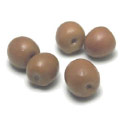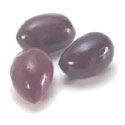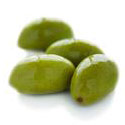Olives are graded into sizes based on either diameter (American standards) or number per kilo or pound (international standards). There are more than 15 grades, from Sub Petite (181 to 220s olive per pound) to Super Mammoth (41-45 olives per pound). In-between are Small, Medium, Large, Extra Large, Jumbo, Extra Jumbo, Giant, Colossal, Super Colossal, Mammoth and other designations that will puzzle olive buyers until labeling includes the number of olives per pound so consumers know the difference among Extra Jumbo, Giant, Colossal, Mammoth, etc.
Traditionally cured olives, such as those found at most olive bars, offer a host of health benefits. For starters, they’re rich in iron, vitamin E and copper, and are an excellent source of fiber. But what about all the fat? It’s true that olives do have some fat, but it’s the incredibly healthy monounsaturated variety.
Monounsaturated fats have been found to reduce the risk of atherosclerosis and increase HDL (good) cholesterol. However, olives contain a triple whammy for your health that works in synergy to provide extreme benefits. Along with monounsaturated fats, olives are rich in vitamin E, a fat-soluble antioxidant that neutralizes damaging free radicals, along with polyphenols and flavonoids, which have anti-inflammatory properties. It is the combination of these three health-boosting compounds that make olives: Have a protective effect on cells that can lower the risk of damage and inflammation, help reduce the severity of asthma, osteoarthritis, and rheumatoid arthritis, help prevent heart disease, help prevent colon cancer, help prevent the frequency and intensity of hot flashes in women going though menopause. When choosing olives for their health benefits (and flavor) always opt for those that have been traditionally cured (as opposed to lye-processed). No matter what the variety, they’re sure to add a burst of flavor and nutrition to any dish.















